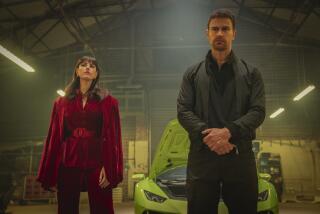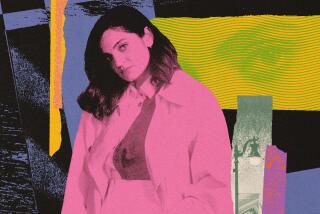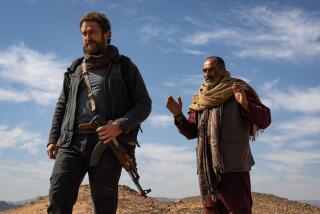The earl of ‘Dukes’
Filmmaker Jay Chandrasekhar, in jeans, a Willie Nelson T-shirt and Birkenstock clogs, is sitting inside the General Lee, the souped-up ’69 Charger that became the hillbilly-kitsch icon of “The Dukes of Hazzard” television show, on the Warner Bros. lot in Burbank. As Chandrasekhar absently waits to have his picture taken, one of those studio-tour mini-trams cruises by, and two youngish guys shout out from their seats, “Hey, Super Trooper!” “I absolutely love it!”
Chandrasekhar grins like a guy firmly in his element and points back at them, warmly responding, “Hey, thanks, guys.”
A short golf-cart ride later and Chandrasekhar is back in the production office where he has been overseeing the completion of “The Dukes of Hazzard,” the big-screen adaptation of the 1979-to-’85 series that brought the General Lee and Daisy Duke cutoffs to the public consciousness. “The Dukes of Hazzard” is Chandrasekhar’s fourth feature film. His first, “Puddle Cruiser,” was financed by a consortium of doctors, relatives and friends of his parents. His second, “Super Troopers,” cost less than $2 million and after modest theatrical success has grown to have a large and intense following on DVD. His third film, “Broken Lizard’s Club Dread,” cost only $8.5 million to make.
Before production began on “Dukes” he had to sign off on the budget -- actually sign something -- regarding a sum in the neighborhood of $50 million.
“I never had to sign a budget before,” he says, laughing at the memory of it. “The reality is, when you’re shooting a scene, you have a camera, some actors, some lights, and what you’re looking at is the same on a $150-million movie or when I made ‘Super Troopers.’ It’s the same.”
This relaxed, easygoing confidence is perhaps the truest hallmark of Chandrasekhar’s personality. It gave him the resolve to more or less hijack the “Dukes” production with the other members of the comedy troupe he helped co-found in college and dubbed Broken Lizard. Its members include Kevin Heffernan, Steve Lemme, Paul Soter and Erik Stolhanske. The script is credited to writer John O’Brien, but no one seems to be hiding that Broken Lizard did a rewrite and left its anarchic, wild-eyed sensibility all over it. (All the members of the Broken Lizard group, including Chandrasekhar, have small roles in the film.)
Starring Johnny Knoxville and Seann William Scott as Luke and Bo Duke, the film also features Jessica Simpson in her feature film debut filling the shorts of Daisy Duke, as well as Burt Reynolds and Willie Nelson as the villainous Boss Hogg and the kindly Uncle Jesse, respectively. The plot revolves around a scheme by Boss Hogg to strip-mine Hazzard County and the Dukes’ efforts to stop it. Along the way there’s a car chase through Atlanta (actually shot in New Orleans), a safe dragged at high speed behind a tow truck, numerous jumps and a chaotic finale in which the Duke boys compete in a road race while simultaneously being chased by cops.
The stunt work is surprisingly hard-core, and thrilling. “You know when you get in a car with that guy in high school,” explains Chandrasekhar, “and he floors it and you’re just terrified? You don’t get in the car with that guy again. That’s how it had to feel.”
Bill Gerber, producer of “The Dukes of Hazzard,” says bringing Chandrasekhar aboard was a calculated choice.
“I really felt with Jay we would get a much edgier movie,” says Gerber. “A tougher, more subversive movie than one might expect.... This was not going to be your standard parody version of the movie.”
On to New York
Both of Chandrasekhar’s parents were born in southern India -- “the deep South,” he jokes -- but he was born in the U.S. and considers himself “a child of the Chicago suburbs.” He went to school at Colgate University in upstate New York and later made the move with the rest of Broken Lizard to New York City. It was there he got a job working for John Sloss, the leading attorney on the New York independent film scene, and got to meet and discuss filmmaking with the likes of directors Richard Linklater, Whit Stillman and Kevin Smith.
After the troupe scraped together the money to make “Puddle Cruiser,” which had some success on the festival circuit (it is scheduled for a DVD release this fall), Broken Lizard made “Super Troopers.” The film, which follows the misadventures of a group of highway patrolmen in Vermont, got into the 2001 Sundance Film Festival.
What “Super Troopers” had was the same rowdy, subversive sensibility that made such movies as “The Blues Brothers” and “Stripes” so popular in their day -- cops chug maple syrup, a guy is stripped naked and doused in powdered sugar, and the back-talking cutups prevail in the end. Chandrasekhar made no bones about the filmmakers he was inspired by and freely borrowed from.
“What I love about Broken Lizard,” says Joshua Deighton, vice president of production for Fox Searchlight Pictures, who bought “Super Troopers” after a midnight screening at Sundance, “and Jay in particular, is as a young filmmaker it is very much in vogue to reference the masters of the ‘70s as Ashby, Rafelson, people like that. .... [But] these guys really appreciate the art of Landis and Reitman and Ramis, which is every bit as valuable and worthy of praise.”
Putting it another way, Deighton asks, “How old were you when you first watched ‘Five Easy Pieces’? And how many times had you seen ‘Animal House’ by then?”
There is another thread of influence running through “Super Troopers” that also found its way into “Dukes” -- the freewheeling CB-era pictures of Hal Needham, such as “Smokey and the Bandit” and “Hooper.”
While the hillbilly -- or “thrillbilly,” as the “Dukes” poster cheekily suggests -- cool of the show is rather timely, with country music making one of its periodic surges in the charts and cowboy boots and Western wear showing up on fashionable bodies, there is one aspect to the “Dukes” redneck mythology that is undeniably troublesome. The Confederate flag. On the roof of a car. Named the General Lee.
While a case can be made for the Confederate flag as a symbol of Southern heritage and pride, there is no denying the racial separatism, bigotry and small-mindedness that are also part of its past.
“It certainly was the elephant in the room,” says “Dukes” producer Gerber.
In something like a comic book-origin story, a subplot in the movie has the General Lee wrecked and subsequently fixed up by Cooter the mechanic and his Civil War reenactor buddies. Bo and Luke unwittingly drive the car into Atlanta without realizing Cooter and the boys have painted a Confederate flag on the roof. They are repeatedly confronted over it, all the while misunderstanding why everyone seems so upset with them.
Chandrasekhar explains, “I wasn’t going to be the guy who took the flag off the General Lee. I thought it was the biggest riddle of the film, the most difficult thing to handle. I think when you’re doing a remake it’s not right to take the central elements and change them because of current politics. I think the better answer is don’t make the movie. Don’t make money off of it if you feel guilty of it.
“There are a lot of people who don’t feel [the flag] should be in statehouses. I’m one of them. But it is a legitimate part of the heritage of the South. There are people who use that flag to promote racial hatred, and I’m obviously the last guy to be into that. It’s a complicated issue for me, but ultimately I loved the show, and I didn’t feel the show stood for racial hatred, or that those guys were bigots.
“When I took the film I said, ‘I don’t love the flag, but it stays on the car and we’re going to figure out the most interesting, funny way to do it that doesn’t solve the debate but acknowledges the debate.’ ”
Overcoming roadblocks
Along the way there have been hurdles big and small to getting the film completed.
During production, Chandrasekhar received a letter from a fan club pleading with him to make sure that Daisy Duke wears pantyhose under her shorts, just as in the television show. Then, Ben Jones, who played Cooter on the original show and is a former Georgia congressman, recently began to mount a campaign badmouthing the movie.
The biggest problem came in the form of a lawsuit that threatened to block the film entirely. Little more than a month before the release of “The Dukes of Hazzard,” it was announced that Warner Bros. had reached a settlement regarding the rights to “Moonrunners,” the little-seen film on which the “Dukes” television show was based. Reported at $17.5 million, the settlement adds a hefty tip to the end of the “Dukes” bill.
“Frankly, it’s kind of depressing,” says Gerber, who says that neither he nor Chandrasekhar was involved in the settlement and know little of its details. “Do I feel a little more pressure about the box office? Yeah.”
Chandrasekhar himself is, not surprisingly, unfazed. “That’s the way it is. The court figured it out and Warner Bros. won’t go under. Yeah, they added $17 million on the end of it. That’s a bummer, but it doesn’t change what I’m doing. Does it have to be a better movie? I couldn’t make a better movie. I put everything I had into it.”
“The Dukes of Hazzard” has also inadvertently landed firmly within two of the hot topics of movie coverage this summer. First, in this the summer of Brad & Angelina and Tom & Katie, does the intensified scrutiny of nonstop celebrity coverage ultimately help or hurt the films the tabloid-scrutinized citizens are ultimately selling? (Simpson, famous now as much for being famous as any particular achievement, generated much media attention throughout the film’s production process regarding her alleged marital woes, her weight, her earrings, you name it.)
Chandrasekhar is typically sanguine. “I think there is such a thing as bad publicity,” he said. But the effect of all the 24/7 scrutiny from the tabloids/TV/internet/whatsis, however, is this: “I think the fact my 65-year-old Indian uncle knows who Jessica Simpson is, and what her supposed romantic issues are, is probably a good sign.”
The second issue of the summer is perhaps a thornier one.
In all the debate about the continuing slump at the box office, the triumvirate of sequels, remakes and adaptations of old television shows has been turned into a mantra of blame. Chandrasekhar’s newest film, his introduction to the big time, obviously fits clearly into this group of villainized cultural products.
He likens the situation to that of “Pirates of the Caribbean: The Curse of the Black Pearl” two summers ago. “I remember thinking that Hollywood must really be scraping the bottom of the barrel, making a feature film about a kid’s ride. I heaped scorn on it before I saw it. And it was hilarious. The filmmakers took it seriously and made a terrific movie about pirates set in the Caribbean.
“And that’s what we did with this movie. The story is about a bootlegging family in Georgia that’s always in trouble with the local authorities.... It’s as serious as ‘The Dukes of Hazzard’ can sustain.”
“Serious” pops up in conversation again and again, like Chandrasekhar’s habit of rolling his thumbs over the first few fingers of each hand as if trying to conjure the point where the concrete meets the ephemeral. He understands that as a maker of rowdy, crowd-pleasing comedies he will likely not get the same critical huzzahs and recognition as if he made films of a different stripe but at the same time has no inclination at the moment to make more high-minded or conventionally respectable films.
“If I had the sensibility to make dramatic movies, I would. As it happens, I make the kind of movies I think I’m good at. I work as hard at making comedy films as any other filmmaker on any other kind of film. John Landis worked as hard on ‘The Blues Brothers’ as Coppola did on ‘The Godfather.’
“I think I already am making serious films.”
More to Read
Only good movies
Get the Indie Focus newsletter, Mark Olsen's weekly guide to the world of cinema.
You may occasionally receive promotional content from the Los Angeles Times.











